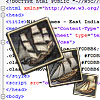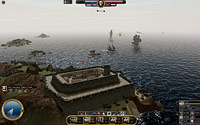- Overviews
- East India Company
- Pirate Bay
- Privateer
- Designer's Cut
- Battle of Trafalgar
- Collection
- Ship Introductions
- Designer's Blog
- Developer's Video Diary
- Modding Instructions-series
 9th October 2009:
9th October 2009:Modding part 6.
This time we learn how to translate the East India Company to your own language.
Read more » 15th July 2009:
15th July 2009:Naval warfare, part II.
Lead designer Kim Soares takes the helm of a frigate and shouts: "Port side, FIRE!"
Read more »
 Keep yourself posted on the latest news about East India Company.
Keep yourself posted on the latest news about East India Company.
Email-address:
 Sign up for the Paradox newsletter, and get all the news directly from Paradox Interactive.
Sign up for the Paradox newsletter, and get all the news directly from Paradox Interactive.
Email-address:


Designer's Blog: Fleet commanders

Commanders are powerful characters that can make the difference in battle.
From the earliest stages of design we wanted to allow players to customize their forces in some way. At first, we opted
for the most obvious way, which was upgrading ships. Like in many other games, the 2004 version of Sid Meier's Pirates!
among them, buying new cannons, sails, hull reinforcements, and so on seemed like the way to go.
However, when we decided that players could have as many as a hundred ships divided into a maximum of twenty fleets, this
was no longer feasible. Buying new sails for a few ships is OK, but having to do it for hundred ships would be irritating.
So, we decided to come up with something else. Something that would give players the possibility to affect the abilities
of their ships and fleets, without forcing them to micromanage things.
To this end, we decided that each fleet will have a Commander. Commanders are a bit like RPG characters in the sense that
they accumulate experience and gain new skills when leveling up.
Each new fleet will have a newbie commander. Players are also able to sack Commanders, hire new ones and switch them between
fleets. As Commanders engage in tactical naval battles with their fleets, they gain experience.
Newbie Commanders start from level 0 and a maximum level for them to reach is 5. Level 5 commanders have 10 different
skills.

Commander Skills
Skills are divided into two categories: active and passive. Passive skills are permanent skills that are in effect all the
time. These include, Navigator, Organizer and Feared for example. Navigator increases the speed of a Commander's fleet while
sailing on a strategic level. Organizer gives bonuses to cargo space as goods are packed into a fleet's ships more efficiently.
Feared Commanders automatically decrease the morale of enemy crews.
Active skills are combat oriented. They are used in tactical battles. To use active skills, players must take direct command
of the flagship of the fleet as this is the ship where the Commander is in control.
This forces players to contribute to the battle personally and also to place their commander and flagship into harms way.
Active skills work in the same way as skills in World of Warcraft for example. They have their own duration and cool down time.
To give you a few examples: Kill Shot enables you to fire devastating broadsides that can turn the tide of battle.
No Surrender will make all friendly ships fight to the bitter end if necessary. Ride the Wind will give the ship
a short speed boost.
As we have tested the Commanders in the game, we're quite satisfied with how they work and what they bring to the overall feel
of the game. They enable players to make choices and make specialized fleets. Some Commanders can just take trading and
navigating skills, which makes them excel as Commanders of trading fleets. Others can become specialists in sinking enemy
ships, routing them from the battle by just making an appearance or conquering ports.
Commanders also have their own faces that you can grow fond of, so when one of them retires or gets killed, you really feel the
loss. When players feel their loss, designers are doing something right.
Kim Soares







